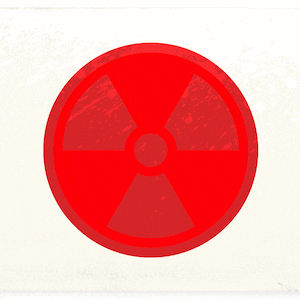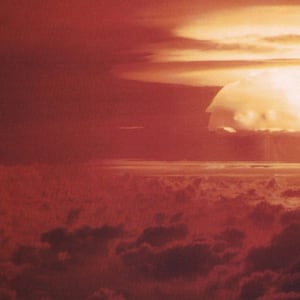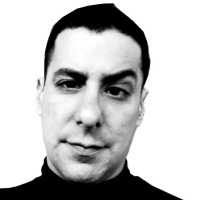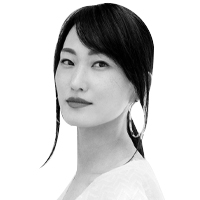TOKYO—What if Japan had been the first to use the atomic bomb in World War II—and what if its top-secret research provided the backbone for the nuclear threat the world now faces from North Korea?
These are some of the tough questions asked in Robert K. Wilcox’s book, Japan’s Secret War, first published in the United States in 1995, but appearing now for the first time in Japan as the world marks the 74th anniversary of the bombing of Hiroshima and Nagasaki.
The book, bound to be controversial here, has been updated extensively, and the subtitle has been changed. Formerly it was “Japan’s Race Against Time to Build Its Own Atomic Bomb.” Now it’s “How Japan’s Race To Build Its Own Atomic Bomb Provided The Groundwork For North Korea’s Nuclear Program.”
Its Japanese translator views it as a nuclear deterrent in itself.
Wilcox has written a number of books examining historical mysteries and conspiracy theories, from the Shroud of Turin to the Kennedy assassination, which may put some readers off. But over the next nearly 24 years since the first publication of Japan’s Secret War he has continued to research this country’s WWII atomic program, building on his already extensive research as he gathered first-hand interviews with Japanese scientists who worked on the project, talked to U.S. officials, gathered classified and declassified documents from many countries, and put together a compelling narrative of Japan’s attempts to acquire the ultimate weapon. (Ironically, this third edition of his book is being published in Japan before it will be published in the United States; it won’t be available in America until January.)
While it is known that Japan was developing an atomic bomb, the scale and intent has been sharply debated. Wilcox notes that U.S. officials, out of political expediency, helped Japan cover up some horrendous war-crimes, including cruel biological experiments on prisoners of war. He argues that in the same vein the U.S. government may also have kept secret much of what it knew about Japan’s nuclear program.
“Make no mistake,” he writes, “Japan would have used the bomb without hesitation or compunction” had it successfully produced one. The Japanese leaders and their scientists “were committed to creating such a device” at a moment when they and other nations “raced against each other and time to make history’s first nuclear weapon. They failed but they were closer to success than history has given them credit for.”
Wilcox makes a case that Japan successfully detonated an atomic device close to what was then called Konan, Korea, on or about August 12, 1945, which is to say six days after Hiroshima was bombed on August 6, killing over 90,000 civilians, and three days after the Nagasaki bomb that killed at least 40,000 people on August 9. Japan’s decision to accept unconditional surrender on August 15, according to Wilcox, came after its own test and, perhaps, the realization that it was too late to respond in kind.
In 1991, William Chapman, a former Washington Post Tokyo Bureau Chief, in his book, Inventing Japan, noted that post-war education here ensured that most people knew little about the suffering of others under Japanese rule.
“For the average Japanese, Japanese atrocities were the rumors of war….The atomic bombings of Hiroshima and Nagasaki, the incendiary raids on [Japanese] cities, these were indisputable…. The war made sense only if Japan were a victim, and that is how a great many people remembered it.”
Those observations are even more true now. The current administration of Prime Minister Shinzo Abe, backed by a strong Shinto cult and right-wing lobby, Nippon Kaigi, has made tremendous efforts to erase memories of Japanese war crimes, or flatly deny them. (This desire to hide the past is likely the driving force behind the current trade war with Korea, which comes after Korea’s Supreme Court ordered Japanese firms to pay added compensation to former Korean slave laborers.)
There are many here who still have no idea Japan was building its own atomic bomb—and almost succeeded—but was too late. The United States was almost too late learning that fact as well.
The U.S. likely became aware that Japan was attempting to develop an atomic weapon by early 1945, and was caught off guard. In February 1945, the OSS (the predecessor to the CIA) circulated a report about “stories” of “an atomic discharge to be used against [Allied] aircraft.”
A few months later, allied intelligence sources filed a report about a scientist rising to speak to the Japanese House of Peers [the parliament of Japan at the time] and announcing “he is succeeding in his research for a thing so powerful that it would require very little potential energy to destroy an enemy fleet within a few moments.” It was clear to those who knew about such things, that the scientist must have been speaking of an atomic bomb. So, when a large Nazi submarine was captured in May of 1945 that was supposed to be carrying a half a ton of uranium to Japan, the U.S. was greatly alarmed.
After the war ended, intelligence officials learned that the Japanese military, just prior to their surrender, had actually developed and successfully test-fired an atomic device. The project had been housed in or near Konan (the Japanese name for Hungnam), on the coast in the northern part of the peninsula.
To make matters worse, by the end of 1945 the Soviets—who did not yet have an atomic bomb—had occupied much of Korea north of the 38th parallel and the plant where the Japanese atom bomb had been developed was under their control.
In the summer of 1946, David Snell, an agent with the 24th Criminal Investigation Detachment in Korea, who had been discharged from service, wrote about it publicly in the Atlanta Constitution. He had interviewed a Japanese officer on his way home from Korea who said he had been in charge of security for the atom bomb project. The name used for the source was an alias. You can read the original dispatch and related dispatches here. Snell wrote:
Japan developed and successfully tested an atomic bomb three days prior to the end of the war…..She destroyed unfinished atomic bombs, secret papers and her atomic bomb plans only hours before the advance units of the Russian Army moved into Konan, Korea, site of the project.
Japanese scientists who developed the bomb are now in Moscow, prisoners of the Russians. They were tortured by their captors seeking atomic "know-how." The Korean project was staffed by about 40,000 Japanese workers, of whom approximately 25,000 were trained engineers and scientists. The organization of the plant was set up so that the workers were restricted to their areas. The inner sanctum of the plant was deep in a cave. Here only 400 specialists worked.
The article summarizes the tactical and strategic goals of the project:
When task forces and invasion spearheads brought the war ever closer to the Japanese mainland, the Japanese Navy undertook the production of the atomic bomb as defense against amphibious operations. Atomic bombs were to be flown against Allied ships in Kamikaze suicide planes.
Since the Soviets did not explode their own device until 1949, it is unclear how much they knew about the Japanese research efforts, in fact, and how useful the intelligence was, or was not. David Holloway, in his scholarly tome Stalin and the Bomb, does not mention the Japanese nuclear program. Much of the Russian research was based on information stolen from the Manhattan Project in the United States.
But in his book, Wilcox sets out to substantiate much of the 1946 scoop and add much more detail.
Japan had been considering an atomic bomb from early in the war and research had taken place in the late 1930s. The original plan was to detonate an atomic bomb in the continental United States. Circa late 1942 or early 1943, Premier Hideki Tojo called Minister of War Gen. Toranosuke Kawashima to his office. He told him, “The atomic bomb projects of the U.S. and Germany are progressing. If we are behind, we will lose the war. You start to make it.”
Japanese scientists had a good knowledge of atomic theory, and they knew they needed massive amounts of uranium. The plan to make an atomic bomb began in earnest, and scientists all across the Japanese empire began working on the project, especially at the Korean complex, where there was a wealth of hydro-electric power and possibly uranium deposits. The Korean site became the Los Alamos of Japan’s Manhattan Project as Japan began searching for uranium all over its empre before, finally, turning to its Nazi allies. They had a source for it in Czechoslovakia.
There are moments of dark comedy in the book as it describes Japan’s attempts to get enough uranium from its German allies. Yasukazu Kigoshi, technical specialist and embassy attaché with the Japanese contingent in Berlin, said at first the German Ministry of Economics was uncooperative.
In his interview with Wilcox, Kigoshi recalled, “So because of my nature, I got very angry and I sent a telegram to the German government by myself. I told them, ‘The reason we need pitchblende [uranium ore] is for the development of atomic power. We are now under the Tripartite Pact [the Axis agreement] and we are both fighting against America and England. So what is going on here that you don’t want to cooperate?’ Either my telegram was good or Oshima [the official] talked to Hitler directly…. They answered that they would give us two tons.”
Toward the end of the war, as Nazi Germany fell apart, a German submarine was dispatched to Japan with two Japanese officers on board and 1,234.59 pounds of uranium oxide for the Japanese military—which if successfully enriched would be enough to make one atom bomb. During the expedition, Germany was defeated and Hitler committed suicide. Less than a week later the ship surrendered to Allied forces on May 14, 1945, roughly 500 miles from Cape Race, Newfoundland. The discovery of the uranium sent off shock-waves.
J. Robert Oppenheimer, the father of the American atomic bomb, is said to have personally come to inspect the cargo. It was requisitioned for the Manhattan Project.
Wilcox notes the “irony” is that uranium bound for Japan’s atomic bombs may have “helped bring atomic devastation to Japan” with the bombing of Hiroshima and Nagasaki in August that same year.
Yoshiaki Yano, who translated the Wilcox book, was formerly a major general in Japan’s Self-Defense Forces and is a noted expert on nuclear deterrents, explains the reasons are more complex.
“The first and second editions were both deemed possibly fabricated for lack of evidence,” Yano told The Daily Beast. “That made things easier for the scientists involved in the development, the industry, and the allies… for Japan to position itself as a nation that was just a victim of nuclear weapons and incapable of possessing these powers itself. The Japanese, especially in the academic world, the media and the education industry took it upon themselves to follow through on this and collectively worked to conceal this part of history and ignore the facts presented in this book.”
Yano also is convinced that the work left behind by Japanese scientists helped create North Korea’s nuclear program as detailed in the book. He is also of the opinion that Japan should have its own nuclear weapons for defense.
“It’s clear that the United States, the Soviet Union, North Korea and China and the Chinese Nationalist Party all must have known the truth about Japan’s nuclear weapons, but have hidden it through and through along with the fact that they have intercepted Japan’s work in the past. The father of North Korea’s nuclear program is very closely connected to Japan. The irony is that Japan is now being threatened by China, Russia and North Korea’s nuclear powers.”
Yano sees the publication of the book as a positive thing.
“The Japanese people and especially the people running this nation should know that Japan has a high potential ability to possess nuclear arms and that [we] do not need to be scared of the nuclear threats.”
He adds, “Japan possesses an independent power of nuclear deterrence. It should strive towards independence in its national defense while actively sharing the management and stabilization of international society.”
In the end, the takeaway from Japan’s Secret War isn’t that the bombing of Hiroshima was justified because the Japanese would have bombed the United States first if they had been faster. The real lesson is that Japan was one more nation that came very close to creating a viable nuclear weapons program, and like Dr. Frankenstein, may have helped create its own monster.
Wilcox calls for further study of Japan’s atomic bomb history and into the reasons the U.S. government still keeps many of the materials classified. The Japanese destroyed much of the research related to their weapons programs at the close of the war, but new evidence continues to be found. Certainly, more study would be merited.
There are lessons to be learned from the tragedies of war, but in order to learn them you have to accept history as it is, not as you would like it to be. And in modern Japan revisionist leaders like Prime Minister Shinzo Abe are more concerned about rewriting history than learning from it. That is also tragic.









